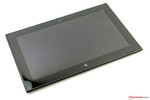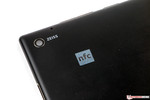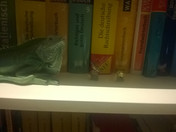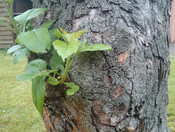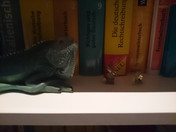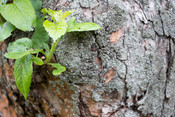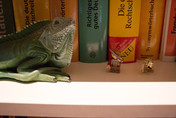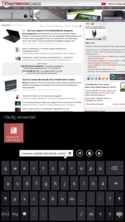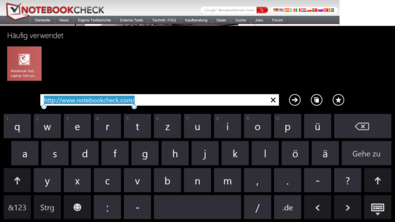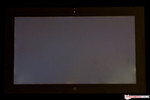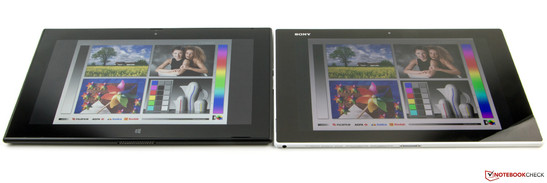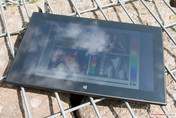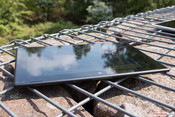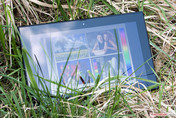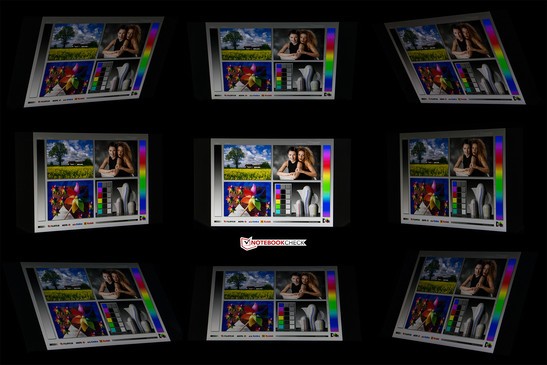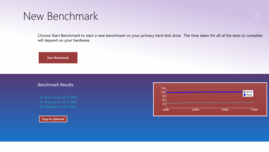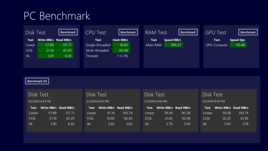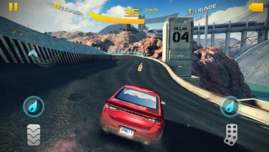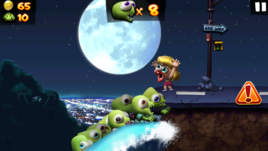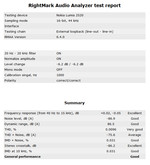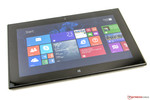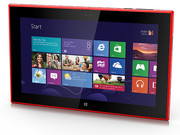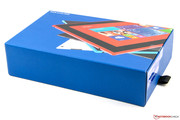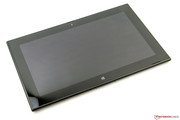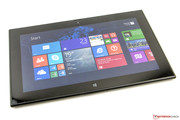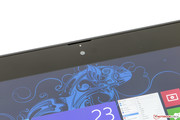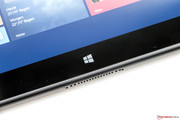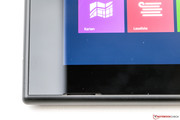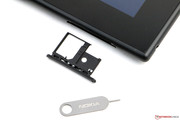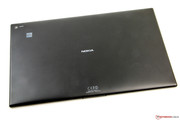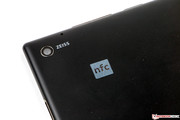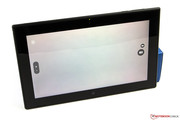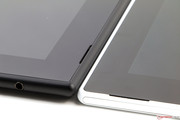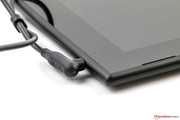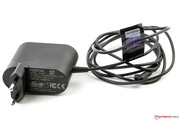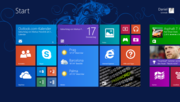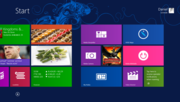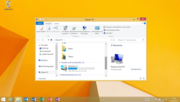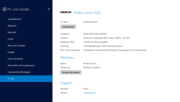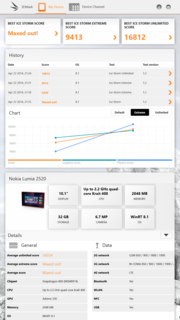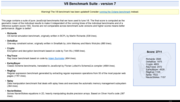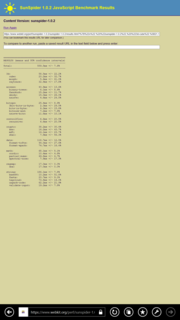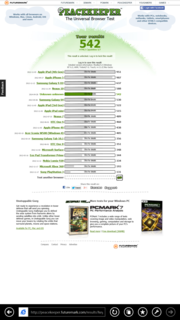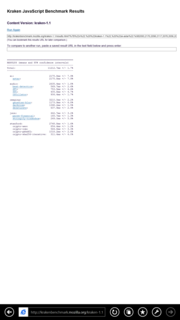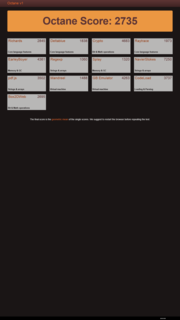Review Nokia Lumia 2520 Tablet

For the original German review, see here.
We Germans had to wait a long time for the Nokia Lumia 2520. Finally, since the beginning of April, the Finnish firm's tablet is available in our corner of the world. Unfortunately, it will remain the last device of this kind made by Nokia, as the mobile device division of the former communications giant was sold to Microsoft on April 25th, 2014. Future products will be released under the name Microsoft Mobile. The Redmond-based company secured the naming rights for a time, which is why we are referring to our test device by its original name here.
The list of components at work in the Lumia 2520 positions the device in the premium segment of the market: Alongside a quick Qualcomm Snapdragon 800 processor, the tablet houses 2 GB of working memory, 32 GB of flash memory and an extraordinarily bright Full HD IPS touchscreen. The LTE module affords users lightning-fast wireless Internet access.
Along with the top-of-the-class Apple iPad Air (starting at 479 Euros; ~$665), the Lumia 2520's competitors include the Samsung Galaxy Note 10.1 (starting at 454 Euros; ~$630), the Sony Xperia Z2 Tablet (starting at 511 Euros; ~$710), the Google Nexus 10 (starting at 399 Euros; ~$555) and the Microsoft Surface 2 (starting at 386 Euros; ~$535). At about 599 Euros (~$830), the Lumia 2520's recommended retail price is comparably high, but it is the only model to come with an LTE modem. Its competitors charge an extra fee for this feature. Still, the tablet is pricy, and it has to prove that what it has to offer is worth the money. The device is not currently for sale in Germany, as the AC-300 power supply included in the package is defective: The plastic coating on the power plug can come off (we wrote about this).
Case
For a modern tablet, the Nokia Lumia 2520 is quite heavy: It measures 267 x 169 mm (~10.5 x 6.6 inches; width x height) and is 8.9 mm (~0.35 inches) tall. At these measurements, the tablet's size is similar to that of the Microsoft Surface 2 (275 x 168 x 8.9 mm, 643 g; ~10.8 x 6.6 x 0.35 mm, ~1.42 lbs), but our review device weighs a little less (about 620 g; ~1.37 lbs). Compared to the extraordinarily thin Sony Xperia Z2 Tablet (266 x 172 x 6.4 mm, 425 g; ~10.5 x 6.8 x 0.25 inches, 0.94 lbs), however, the Lumia 2520 is no skinny little thing.
The case's soft polycarbonate is a typical choice for the Finnish company's Lumina devices. In terms of how it feels to the touch, the tablet is great. Due to its rounded edges, despite its comparatively high weight the device feels good in your hands. Unfortunately, the Lumia 2520's stability is not particularly impressive: The wide frame around the display proves to be very sensitive to pressure. Just holding the tablet in one hand can put enough pressure on the screen for waves to form on the edge of the panel. If you apply pressure around the frame, these waves are clearly visible. Additionally, when we pressed our finger against the back of the device, waves were once again visible on the screen.
The device's resistance to twisting is more or less average: The tablet makes a soft creaking sound as it gives. It also produces a rustling sound, as if someone were crumpling foil. The gaps between the various pieces of the case are almost all perfectly even; the only exception is that the connections on the right side of the tablet stick out ever so slightly. The card reader cover in particular is not quite even with the rest of the case and juts out a little. We are somewhat disappointed here; as such shortcomings in manufacturing quality are abnormal both for a premium product and for Nokia.
Connectivity
The Nokia Lumia 2520's connectivity options are quite extensive. Next to the Micro HDMI port, there is also a Mini USB 3.0 port. Unfortunately, unlike on the Surface 2, this is not a standard port, so an adapter is needed to connect a USB stick or a mouse. Also, the tablet can only be charged through the 2.5 mm charging connection on the opposite side. It is somewhat difficult to distinguish between this power connection and the nearby audio port.
The Micro SIM and MicroSD slots are housed in the head of the tablet. Using a tool included in the package, the cover can be removed and the holder for the cards exposed. This is somewhat impractical if one of the cards needs to be switched out. The tablet supports MicroSD cards up to 64 GB in size.
Software
Nokia's operating system of choice for their Lumia 2520 is Microsoft Windows RT 8.1. As usual, the touch-optimized version of Microsoft Office is also installed. There are several proprietary Nokia apps on board as well. We are already familiar with these apps, as they run on the company's smartphones too. The list includes Storyteller, MixRadio, Video Director, Nokia Camera and Here Maps. The latter was adjusted to fit the tablet's display, and Nokia MixRadio is completely free on the Lumia 2520. Only the modification of the camera app proved to have been executed imperfectly: All the functions available on Nokia's smartphones are integrated, but the app crashed often. Usually, even rebooting the tablet did not remedy the problem, which left us no other recourse but to reinstall the program.
Communication & GPS
The Nokia Lumia 2520 can access the Internet via its WLAN and WWAN modules. The former supports the IEEE 802.11 standards a/b/g/n and operates in the 2.4 and 5.0 GHz frequency ranges. The components' reception range is quite good. Even 15 meters (~49 feet) from the router (Fritz!Box 6360), we still had average reception and could surf the Internet with minimal delays.
The WWAN modem from Qualcomm makes access to the World Wide Web possible in transit as well. Alongside UMTS/HSPA+ (upload: max. 11.5 MBit/s, download: max 42.2 MBit/s), LTE Cat. 4 is also on board. The latter only supports three bands, but these are sufficient for use within Europe. The download rate reaches up to 150 MBit/s.
A GPS and Glonass receiver is also integrated into the Lumia 2520. Even indoors, the tablet determined our location within a few seconds and positioned us very accurately. Since Here Maps makes offline navigation possible, the tablet works well as a navigational aid.
The tablet handles Skype calls very well. The integrated microphone does a great job picking up voices, and the speakers render voices excellently as well. Both NFC and Bluetooth 4.0 are also on board. The latter simplifies data transfer to a computer and enables streaming of audio content.
Cameras & Multimedia
The Nokia Lumia 2520 has two cameras. The webcam on the front side has a resolution of 0.9 MP (1280x720 pixels). That is not especially high, but for video calls, it is generally sufficient. This is no device for taking selfies, however, as the pictures are very blurry and grainy.
The main camera's resolution theoretically reaches up to 6.7 MP. Snapshots taken in 4:3 format, however, are only 2848x2136 pixels in size (6 MP). It is entirely possible that the missing 700,000 pixels are reserved for the digital zoom. Those who prefer to take pictures in 16:9 format will have to make do with an even lower pixel density, as the resolution only reaches 3072x1728 pixels (5.3 MP). The lens has an impressive aperture of f/1.9, which means that it ought to have a high light sensitivity.
The tablet has both the Windows photo app and Nokia Camera. We are already familiar with the diverse settings options from Nokia's smartphones. Unfortunately, the version for Windows RT does not yet seem fully developed. In our tests, the app often crashed and would only restart after reinstallation. In addition, the shutter release delay lasted about two to three seconds. Snapshots are not possible under these circumstances.
The picture quality leaves something to be desired. We definitely expected more from a PureView camera with six Zeiss lenses. The problem is not only software-related, as the image quality did not improve when we used Windows' internal app, though the shutter release was quicker. The colors look very unnatural, and pictures taken in daylight have a red cast. On photos of landscapes, the details blur into a mess of pixels. Close-up shots in the daylight look considerably better, though the images grow substantially more blurry as you move towards the edges. In weak light, the photos look grainy, and a fog-like green haze lies over them. In summary, the Lumia 2520's picture quality is no more than mediocre and falls far behind the competition.
Accessories
Besides a few quick-start guides, the Nokia Lumia 2520 comes accompanied by a little tool that helps open the cover protecting the MicroSD and Micro SIM cards. The AC-300 (20 Volts, 1.5 Amps) power supply included in the package has already caused a sensation: On some units, parts of the covering have come off and left the user in danger of electric shock. Due to this problem, the device is temporarily not for sale. Anyone who has already purchased the tablet can order a power supply replacement. Microsoft Mobile offers the necessary support on Nokia's website.
In terms of accessories specific to the Lumia 2520, for another 199 Euros (~$275), Nokia offers a plug-in keyboard that doubles as a protective cover. The external input device also includes two more USB 3.0 ports and an additional battery.
Warranty
Nokia only affords the Lumia 2520 a 12-month warranty. It is not possible to extend this short warranty period. Individual consumers in the EU, however, will also obtain the mandatory two-year manufacturer's warranty.
Input Devices & Operation
The Nokia Lumia 2520 is equipped with a 10.1-inch capacitive touchscreen that can process up to five touch inputs at once. The screen reliably recognizes input on the touch-sensitive display surface and reacts promptly. Even at the edge of the display, the tablet has no problem accepting input. Theoretically, the materials used for the screen surface should alz`low fingers to glide across the display very easily and comfortably. Unfortunately, however, the Gorilla Glass covering the panel is not completely flat, so fingers are ever so slightly caught as they glide across the screen.
The power button and the volume rocker are easy to identify by touch and have a clear click-point. Since a tablet is usually held in landscape format, positioning the buttons at the head of the device is somewhat impractical, as the user has to awkwardly shift hand positions to reach them. The Windows sensor button is located on the bottom portion of the display frame. Unfortunately, this key feels no different from the rest of the frame and is not backlit, so in the dark it is easy to miss it. Furthermore, our input on the sensor's surface often was not recognized.
Display
The Nokia Lumia 2520 has a 10.1-inch IPS display with a resolution of 1920x1080 pixels (Full HD). This corresponds to an aspect ratio of 16:9 and a pixel density of about 218 ppi. Image content looks sharp and individual pixels are not visible. When Nokia presented the Lumia 2520, they emphasized the fact that a tablet is mobile and therefore ought to be readable in every kind of lighting situation. In light of this, the manufacturer promises an incredible brightness level of 650 cd/m².
And it is true! The tablet's display actually even exceeds these numbers, reaching a brightness of up to 753 cd/m². At an 82% similarity across the screen, the panel's brightness distribution could be more uniform. The visible clouding on the rim of the panel is frustrating. Clouding should never be present in this price class, as it is distracting during dark film scenes. The Sony Xperia Z2 Tablet (max. 467 cd/m², 89%) does not have this problem at all, though it is nowhere near as bright. On the other hand, its brightness distribution is very consistent. The iPad Air (max. 473 cd/m², 90%) is even more evenly lit.
| |||||||||||||||||||||||||
Brightness Distribution: 82 %
Center on Battery: 753 cd/m²
Contrast: 978:1 (Black: 0.77 cd/m²)
ΔE ColorChecker Calman: 5.12 | ∀{0.5-29.43 Ø4.78}
ΔE Greyscale Calman: 6.46 | ∀{0.09-98 Ø5}
Gamma: 2.4
CCT: 6101 K
At 978:1, the Nokia Lumia 2520's contrast is very good. However, at 0.77 cd/m², the black value is a little high and proves to be the second-worst number among the tablet's competitors. Only the Samsung Galaxy Note 10.1 (493:1, 0.84 cd/m²) does a worse job here. The iPad Air is considerably superior in this discipline (1154:1, 0.41 cd/m²), delivering the best black value of them all. Nokia's own competing products offer better numbers here as well. The Surface 2's black value comes to 0.51 cd/m² (contrast: 700:1). Because our test device's brightness is extraordinarily high, it is not particularly surprising that its black value is on the higher side. None of the competing devices have a display as bright as the Lumia 2520's.
The Nokia tablet's panel is well calibrated, though according to the experts at DisplayMate, it only covers 75% of the sRGB color space. The iPad Air manages to cover almost 100%, while the Surface 2 only manages 63%. Our test device's display of color is also quite good. Only white and blue deviate significantly from the ideal DeltaE 2000 values, and they stay below the critical value of 10. The grayscale results are also acceptable and reach an average DeltaE of 6.5. The closer you move towards white on the grayscale, the greater the deviation. In the sRGB target color space, mixed colors (dE 5) are displayed somewhat more accurately. Here too, white and blue are outliers. All in all, the deviations produce a slight green cast, but in practice this is hardly noticeable.
Even though the Nokia tablet's results here are reasonably good, compared to the competition it does very poorly. The competitors do not even reach a dE of 3, which means the color deviations are generally not even visible to the trained eye. This is not true of our test device. Once again, the iPad Air proves to be exemplary in this area.
In outdoor use, the Nokia 2520 is the top of the game. Its very good contrast value, paired with its incredible brightness, makes the display content easily visible in very bright environments. Even direct sunlight does not make use of the tablet impossible, despite the fact that the display's reflective surface is a little bothersome. Still, outdoors the Lumia 2520 is almost unrivaled. Here our test device does not fail to impress in any respect -- the only device that is superior here is the Panasonic FZ-G1. Our video shows a direct comparison between our test device and the Sony Xperia Z2 Tablet.
The Nokia Lumia 2520's viewing angle stability is very good. Due to the fact that the panel uses IPS technology, that was to be expected, but there is truly nothing to complain about here. The only position in which the screen loses a little brightness is at angles over 45 degrees. We are happy to report that even from very flat viewing angles, the screen does not produce any ghost effects, as the distance between the display glass and the panel is not too big. Even the top-class Apple iPad Air could learn a thing or two from the Lumia here.
Performance
The Nokia Lumia 2520 houses a fast Qualcomm Snapdragon 800 MSM8974 SoC. This chip operates at a clock frequency of 2.15 GHz and has four cores. The chip-manufacturer's former flagship still counts among the fastest processors on the market and catapults the tablet into the high-end segment. The 2 GB of working memory is sufficient for the tasks the tablet should be able to perform. The Qualcomm Adreno 330 is responsible for graphics computation.
Unfortunately, the benchmark programs available under Windows RT are not particularly numerous. As a result, we had to limit our tests to the few cross-platform apps available. Even so, we did get some interesting results. In GFXBench, for the most part the Lumia 2520 did just as we expected; only the offscreen value came in a little lower than that of the competition with similar hardware. In 3DMark Ice Storm Unlimited, the tablet gained a good 16,812 points. Compared to its competitors, only the Sony Xperia Z2 Tablet (18,806 points) proves to be faster, likely because its graphics unit has a somewhat higher clock frequency. However, when it comes to the physics scores too, the 2520 does considerably worse than what the SoC should theoretically be capable of. The processor's reduced clock rate (2.2 GHz) could be responsible for this. Still, the overall package offers more than enough performance and gives the system enough oomph to operate fluidly.
| GFXBench (DX / GLBenchmark) 2.7 | |
| T-Rex Onscreen (sort by value) | |
| Nokia Lumia 2520 | |
| Google Nexus 10 | |
| Microsoft Surface 2 | |
| Samsung Galaxy Note 10.1, 2014 Edition | |
| Apple iPad Air 1 2013 | |
| Sony Xperia Z2 Tablet | |
| 1920x1080 T-Rex Offscreen (sort by value) | |
| Nokia Lumia 2520 | |
| Google Nexus 10 | |
| Microsoft Surface 2 | |
| Samsung Galaxy Note 10.1, 2014 Edition | |
| Apple iPad Air 1 2013 | |
| Sony Xperia Z2 Tablet | |
| 3DMark | |
| 1280x720 offscreen Ice Storm Unlimited Score (sort by value) | |
| Nokia Lumia 2520 | |
| Microsoft Surface 2 | |
| Samsung Galaxy Note 10.1, 2014 Edition | |
| Apple iPad Air 1 2013 | |
| Sony Xperia Z2 Tablet | |
| 1280x720 offscreen Ice Storm Unlimited Graphics Score (sort by value) | |
| Nokia Lumia 2520 | |
| Microsoft Surface 2 | |
| Samsung Galaxy Note 10.1, 2014 Edition | |
| Apple iPad Air 1 2013 | |
| Sony Xperia Z2 Tablet | |
| 1280x720 offscreen Ice Storm Unlimited Physics (sort by value) | |
| Nokia Lumia 2520 | |
| Microsoft Surface 2 | |
| Samsung Galaxy Note 10.1, 2014 Edition | |
| Apple iPad Air 1 2013 | |
| Sony Xperia Z2 Tablet | |
The Nokia Lumia 2520 does a fairly good job surfing the Internet. Subjectively, Internet Explorer 11, navigates quickly through the World Wide Web. However, the benchmarks do not quite corroborate this assessment: Compared to the competition, our test device comes in last in almost every area. As usual, the tablets with Windows RT strut their stuff in Sunspider. Still, the Lumia 2520 is somewhat slower than the Surface 2, even though it has a stronger SoC at its command.
| Peacekeeper - --- (sort by value) | |
| Nokia Lumia 2520 | |
| Google Nexus 10 | |
| Microsoft Surface 2 | |
| Sony Xperia Z2 Tablet | |
| Samsung Galaxy Note 10.1, 2014 Edition | |
| Apple iPad Air 1 2013 | |
| Mozilla Kraken 1.1 - Total (sort by value) | |
| Nokia Lumia 2520 | |
| Microsoft Surface 2 | |
| Sony Xperia Z2 Tablet | |
| Samsung Galaxy Note 10.1, 2014 Edition | |
| Apple iPad Air 1 2013 | |
| Octane V2 - Total Score (sort by value) | |
| Nokia Lumia 2520 | |
| Microsoft Surface 2 | |
| Sony Xperia Z2 Tablet | |
| Apple iPad Air 1 2013 | |
| Sunspider - 1.0 Total Score (sort by value) | |
| Nokia Lumia 2520 | |
| Microsoft Surface 2 | |
| Sony Xperia Z2 Tablet | |
| Samsung Galaxy Note 10.1, 2014 Edition | |
| Apple iPad Air 1 2013 | |
* ... smaller is better
The Nokia Lumia 2520 is outfitted with 32 GB of internal flash memory. However, after the first system startup, only 16.6 GB remain available to the user. Windows RT 8.1, with all its software and its recovery partition, takes up almost half of the storage space. The amount of space left over is somewhat disappointing.
The New Benchmark and PC Benchmark programs certify that the memory is relatively speedy. In the sequential read test, the tablet reaches up to 143 MB/s. Reading smaller files (4k) too, at 3.54 MB/s, the Lumia processes at a respectable speed. The Sony Xperia Z2 Tablet (512k: 63 MB/s, 4k: 12 MB/s) also has a quick flash memory and surpasses our test device by a long shot in the 4k read test.
Games
With its Qualcomm Adreno 330, the Nokia Lumia 2520 is very well equipped to run any game in the Windows Store, whether graphically simpler titles like Zombie Tsunami or current highlights like Asphalt 8: Airborne.
The sensors operate cleanly and the touchscreen functions well, adding to the fun gaming experience. The only minor problem is that the comparably high weight of the device tires your arms quicker than lighter tablets would.
Emissions
Temperature
The Nokia Lumia 2520's surface temperatures already reach up to 33.6 °C (92.48 °F) while idling. That is a comparably high temperature, but still completely unproblematic. Only the Galaxy Note 10.1 warms up as much as our test device. The coolest of the competitors are the Surface 2 (max. 28.2 °C; 82.76 °F) and the Xperia Z2 (28.8 °C; 83.84 °F).
We used the Relative benchmark to simulate the system under full load and ran it for over an hour. During the test, our tablet's temperatures climbed to up to 41.1 °C (105.98 °F). Here too, the Lumia 2520 is one of the warmest devices; only the iPad Air (max. 42.1 °C; 107.78 °F) grows even warmer. The Surface 2 (max. 35.3 °C; 95.54 °F) and the Note 10.1 (max. 35.6 °C; 96.08 °F) remain well beneath the 40-degrees Celsius mark (104 °F). Remember, these are extreme numbers that a tablet will seldom reach in everyday use.
(+) The maximum temperature on the upper side is 37.3 °C / 99 F, compared to the average of 33.7 °C / 93 F, ranging from 20.7 to 53.2 °C for the class Tablet.
(±) The bottom heats up to a maximum of 41.1 °C / 106 F, compared to the average of 33.2 °C / 92 F
(+) In idle usage, the average temperature for the upper side is 29.3 °C / 85 F, compared to the device average of 30 °C / 86 F.
Speakers
The Nokia Lumia 2520 has two stereo speakers on the front side of the device. The manufacturer chose an excellent position for these speakers. They are located in the lower portion of the long side of the frame, so they are not covered by your hands when the tablet is held in landscape format. The speakers' volume is also fairly good. However, at high volumes, high tones tend to exceed pleasing levels. Mid-tones sound good, while the bass is a little flat. Still, compared to the Xperia Z2 Tablet, the speakers offer a good sound, though they cannot quite keep up with the iPad Air.
The stereo plug also achieves good results. In RightMark Audio Analyzer, the audio output only shows weaknesses in the area of harmonic distortion (THD); otherwise, the audio port made a very good impression on us.
Energy Management
Power Consumption
In idle mode, the Nokia Lumia 2520's energy consumption rate lies between 2.2 and 6.4 Watts. Even with its incredibly bright display, the tablet needs less energy than the iPad Air (max. 7.1 W) and the Note 10.1 (max. 6.5 W).
Under full load, which we simulated using the Relative benchmark, the Lumia uses up to 14.5 Watts. The Surface 2 (max. 15.8 W) uses more energy in this scenario. The rest of the competition consumes significantly less energy; all of the devices use less than 11 Watts. In fact, the Sony Xperia Z2 Tablet only needs 7.4 Watts.
At 30 Watts, the Lumia 2520's power supply's power rating is unusually high. However, the notebook battery inside the device is not common either. The Nokia BC-3S is a lithium-polymer battery. The manufacturer indicates that the battery's capacity is 8120 mAh, though the Internet provides different specs. These sources claim the battery's capacity is only 2030 mAh, but at a high 14.8 Volts, the numbers specified also equate to a capacity of about 30 Wh. If you consider these 30 Wh in relation to a typical lithium-polymer battery's voltage (3.6 V), you reach the advertised 8120 mAh. At any rate, the battery explains the unusual power supply.
| Off / Standby | |
| Idle | |
| Load |
|
Key:
min: | |
Battery Life
The bright display needs a lot of energy, hence the manufacturer's choice to equip their tablet with a powerful battery. As a result, the Nokia Lumia 2520 proves to have a very good battery life. We determined the battery's maximum run time using an online script that simulates reading a book. All superfluous energy-guzzlers (communications modules, etc.) were deactivated and the display brightness was set to minimum. The tablet plodded along for over 16 hours. That is no record-breaking time, but it is good. To create the opposite scenario, the panel brightness was set to maximum and all the components that use energy were activated. With the help of the Relative benchmark, we then drained the battery as fast as possible. The lights went out after three hours -- similar to the competing Surface 2 (03:15).
The tests we run at an adjusted display brightness of about 150 cd/m² produce results that are easier to compare. When playing the video Big Buck Bunny in Full HD, the Lumia 2520 runs out of steam after 11 hours and 19 minutes. This is a great time, though some of the competition can top it. The Surface 2 lasts over twelve hours, and the Xperia Z2 Tablet even reaches the 14-hour mark. In our "surfing over WLAN" test, a script is run in the browser that loads a new website every 40 seconds. Here too, at 13 hours and 23 minutes, our test device reaches an excellent run time. Of the competitors, only the Samsung Galaxy Note 10.1 (18:25 h) proves to have more stamina.
With this kind of battery performance, a user should easily be able to get through a day on-the-go without needing to plug into the wall. If the Lumia 2520 does need to be charged, after just 1.5 hours it is back at 100%.
Verdict
All in all, the Finnish company produced a good tablet for their first try, though there is room for improvement. The typical Lumia design bears an unmistakable similarity to their smartphone line. The crowning jewel of the Nokia Lumia 2520 is most assuredly its incredibly bright display that glows even brighter than the promised 650 cd/m². Anyone who is often on-the-go or just likes to spend time outside will enjoy this tablet. Its battery life, too, is very good, and the integrated LTE modem makes it possible to get on the Internet easily throughout all of Europe. Because of its very good microphone, phone calls over VoIP are no problem either.
But the tablet proves to be plagued with uncommon weaknesses in the area of manufacturing. The device is very sensitive to pressure, and when just holding the tablet waves can form on the display. The panel's visible clouding should not be present in this price class either. Otherwise, the screen has a very high contrast and displays colors vibrantly. When it comes to battery life and recharge speed, the unusual battery and power supply combo do their job well, though unfortunately the tablet can only be charged via the 2.5-mm charging connection. We deducted a little from the overall score for the Nokia Camera app's frequent crashes.
The biggest limiting factor is still the small range of apps available in the Windows Store. As soon as this store merges with its Windows Phone counterpart this will be much improved, but compared to the competition put forward by Google or Apple, the selection will still be limited. Nevertheless, Microsoft Mobile's Lumia 2520 is a good tablet that we can easily recommend.




